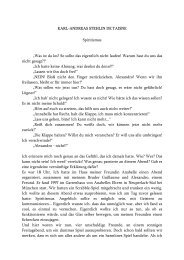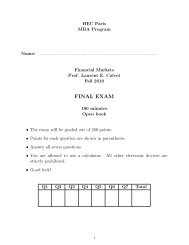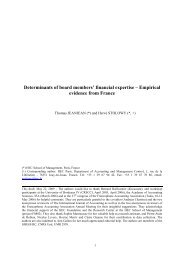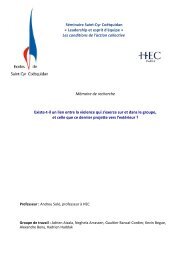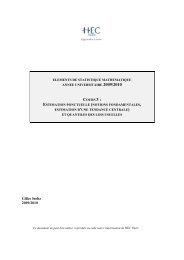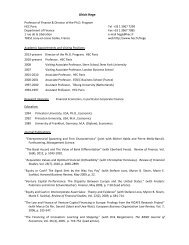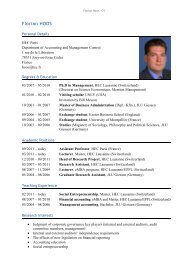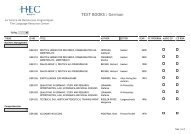Multifractality of US Dollar/Deutsche Mark Exchange Rates - Studies2
Multifractality of US Dollar/Deutsche Mark Exchange Rates - Studies2
Multifractality of US Dollar/Deutsche Mark Exchange Rates - Studies2
Create successful ePaper yourself
Turn your PDF publications into a flip-book with our unique Google optimized e-Paper software.
1 Introduction<br />
<strong>Multifractality</strong> is a promising new tool for economists. Recent theoretical research proposes the<br />
Multifractal Model <strong>of</strong> Asset Returns (“MMAR”) as a method <strong>of</strong> modelling financial prices. (Man-<br />
delbrot, Fisher and Calvet, 1997; Calvet, Fisher and Mandelbrot, 1997; Mandelbrot, 1997). The<br />
MMAR is thus an alternative to ARCH and its variants. Multifractal processes incorporate long-<br />
tailed asset returns and long memory in “volatility”. Additionally, the MMAR predicts a form <strong>of</strong><br />
scaling in the moments <strong>of</strong> returns that is new to both theoretical and empirical finance.<br />
Current finance literature notes a discrepancy between financial theory, which is largely set<br />
in continuous time, and empirical research that tends towards discrete formulations. (Rossi, 1997;<br />
Drost and Werker, 1996; Melino, 1994) This discrepancy is sometimes viewed as a “gap” to be reme-<br />
died by improvements in empirical models. <strong>Multifractality</strong> <strong>of</strong>fers a different perspective, showing<br />
that a large class <strong>of</strong> interesting stochastic processes are not covered by the Itô diffusion paradigm. 1<br />
Importantly, the MMAR contains a restriction, scaling, that is strong enough to generate empiri-<br />
cal tests. “Scaling” describes a specific relationship between data samples <strong>of</strong> different time scales,<br />
e.g. daily, weekly, or monthly returns. 2 We envision a growing set <strong>of</strong> econometric methods that<br />
explicitly test or model the behavior <strong>of</strong> data at different time scales. Established research along<br />
these lines includes the literature on decreasing sequences <strong>of</strong> ARCH representations (Nelson, 1990;<br />
Nelson and Foster, 1994; Drost and Werker, 1996). This work assumes a decreasing sequence <strong>of</strong><br />
sampling frequencies, and therefore matches the natural continuous time framework <strong>of</strong> the MMAR.<br />
The present paper conducts the first empirical investigation <strong>of</strong> the MMAR. The empirical work<br />
uses an estimation technique that is new to economics, and is validated through simulation. Simu-<br />
lations also are used to illuminate important differences in a core group <strong>of</strong> extant financial models.<br />
Overall, the empirical results are quite promising for the MMAR, showing strong regularities in<br />
an important data set that are consistent with restrictions imposed by multifractality. We hope<br />
1 Itô diffusions are locally quadratic, allowing arbitrage arguments and other mathematical conveniences that would<br />
require distributional assumptions in discrete time. Theoretical results that depend critically upon It ô diffusions<br />
are generally understood to be idealized, and problematic because <strong>of</strong> the presence <strong>of</strong> discontinuities. The MMAR<br />
reinforces reservations about the “continuous hedge” by postulating a more generally diverse variety <strong>of</strong> local behavior.<br />
Even when price paths are continuous, they in general are not locally quadratic.<br />
2 A similar term that has been used in these papers is “scale-consistent”, which has the same meaning as “closed<br />
under temporal aggregation”. By this, we mean that the class includes a representation <strong>of</strong> the process at each discrete<br />
time scale. Thus, GARCH is not scaling, but under certain assumptions, is scale-consistent. (See Drost and Nijman,<br />
1993).<br />
1



